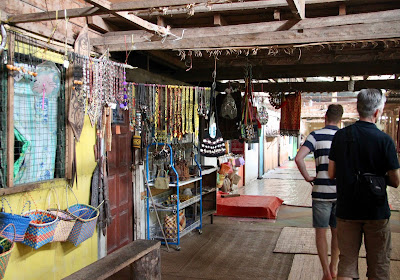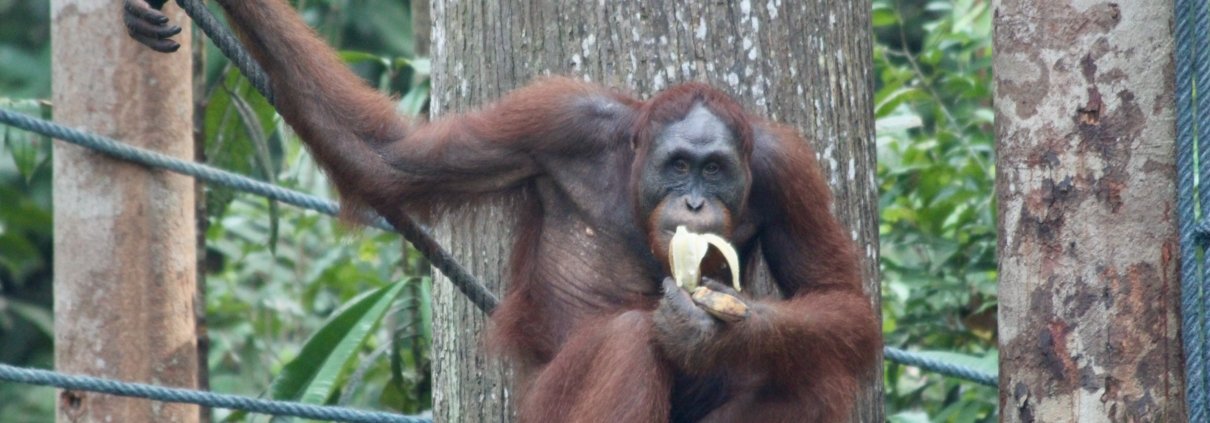Touring the Malaysian states of Sarawak & Sabah:
We – two families with an adult son each – had been looking for a destination in Southeast Asia for summertime. This undertaking had been complicated by the fact that the rainy season falls over the summer months. Finally, we settled for North Borneo as there is high season in July. In addition, we are nature lovers and wanted to spend some lazy days on the beach after exploring the sights. The Malaysian states of Sarawak and Sabah seemed to be the perfect choice for our needs.
We did not do the planning ourselves, but booked a private 8-day tour from Kuching to Kota Kinabalu with a Swiss tour operator (Tour Asia). In this post you find the details of our trip with my comments. My next post will be about the hotels we stayed at during our North Borneo tour.
 |
| Myself on a longboat on my way to Iban people |
General
Borneo, the third largest island in the world and the largest one in Asia, is shared among three countries: Malaysia, Indonesia and Brunei. The northern third of the island with its states Sarawak and Sabah belongs to Malaysia and is largely covered with rainforest, one of the oldest ones in the world.
While Sarawak with its capital Kuching is known for its historic, cultural and natural attractions, Sabah with its capital Kota Kinabalu is known for its wildlife, national parks and beaches.
 |
| Longboats at Gunung Mulu National Park |
An 8-day itinerary
Kuching, the capital of the state of Sarawak, is the gateway for exploring sites such as Semenggoh Wildlife Center, Iban people and Bako National Park. It is a bustling city with a mix of colonial and modern buildings along a river waterfront.
 |
| Kuching river waterfront |
My opinion: While the city of Kuching has a certain charm, sights really worthwhile seeing are missing.
 |
| Kuching city center |
Our first stop was at Semenggoh Nature Reserve where young orangutans are trained how to survive in the wilderness. During the feeding sessions there is a good chance of seeing semi-wild orangutans returning for a free meal from time to time.
 |
| Orangutan at Semenggoh Nature Reserve |
The next destination was Batang Ai Lake, the starting point for a trip to Iban people. These natives from Borneo who used to practice headhunting in former times, still live in longhouses, a special type of accommodation.
My opinion: If you visit Borneo, you absolutely have to see orangutans because they can be found (worldwide) only on Borneo and Sumatra. That is why going to Semenggoh Nature Reserve is a must-see.
 |
| Batang Ai Lake |
Day 3: Iban people (Lemanak River)
This day was dedicated to a visit to the Iban peopleto get an insight into their culture and customs. A trip with a longboat on the Lemanak River brought us to one of their traditional longhouses.
 |
| Arriving with Iban people after longboat trip |
My opinion: Visiting a longhouse with Iban living in it is an interesting thing to experience, but I could not help feeling like a voyeur.
 |
| Interior of longhouse |
After returning to Kuching, a trip to Bako National Park, was scheduled. This park offering diverse natural landscapes is the home to around 150 highly endangered proboscis monkeys with its distinctive nose and other wildlife.
 |
| Coastline at Bako National Park |
My opinion: This National Park is worthwhile seeing as there are great trails where you can admire the beautiful nature and of course the long-nosed monkeys are a top attraction.
 |
| Proboscis (long-nosed) monkey |
On both days, we went to Gunung Mulu National Park, an UNESCO World Heritage Site. It is an area of exceptional natural beauty with a high biodiversity and karst features. You find there the largest caves on earth, which are home to millions of bats.
 |
| Bats leaving cave at Gunung Mulu National Park |
My opinion: There is quite a number of caves to be seen here. My advice is not to visit too many, but to concentrate on 2 or 3 of them. What I like best here is the exit of an enormous colony of bats in a spectacular exodus at Deer Cave, not to be missed!
 |
| Interior of a cave at Gunung Mulu National Park |
Kota Kinabalu, the capital of the state of Sabah, was the endpoint of our Borneo tour. In contrast to Kuching, it is a modern city with no or only little cultural heritage as it was destroyed by fire in the late 1800s and only rebuilt in the mid 1900s.
 |
| View of Kota Kinabalu |
My opinion: Kota Kinabalu has a rather modern feel, but – as Kuching – misses really important sights.
 |
| Night market in Kota Kinabalu |
The last trip was dedicated to Kinabalu Park, Malaysia’s first UNESCO World Heritage Site. The park is dominated by Mount Kinabalu (4,095 m), one of the highest mountains in South East Asia, and has a variety of flora and fauna ranging over 4 climate zones.
 |
| Mount Kinabalu |
My opinion: Whereas Mount Kinabalu is impressive to look at from a distance, it is rather difficult to experience unless you want to climb Malaysia’s tallest mountain (no easy thing to do). At Kinabalu Park there are various trekking trails and a Botanical Gardens.
 |
| Botanical Gardens at Kinabalu Park |
Tour evaluation
The nature highlights of North Borneo are really worth a trip. The place I like best is Bako National Park. Its coastline with steep cliffs, rocky headlands and sandy beaches is amazing. Also flora and fauna have a lot to offer, from 25 types of vegetation from 7 ecosystems to an abundance of wildlife, above all the endemic proboscis monkeys.
 |
| Rafflesia, the largest flower on earth (near Kinabalu Park) |
Malaysia is one of the richer countries in Southeast Asia and therefore a mix between a modern and a developing nation. Further, the landscape – when not being in a national park – is neither especially scenic nor exotic. Also we found that the local people are a bit reserved when dealing with tourists.
In short: the Malaysian part of Borneo has an abundance of natural attractions, but it is certainly not the most idyllic part in Southeast Asia.
 |
| Iban people cooking food in bamboo stems |
Date of stay: July 2015






















Leave a Reply
Want to join the discussion?Feel free to contribute!